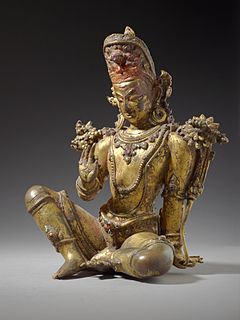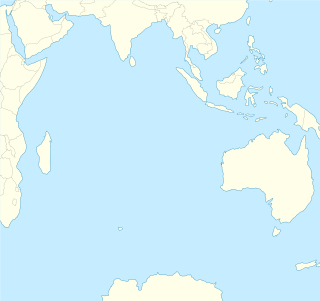
Asuras are a class of divine beings or power-seeking deities related to the more benevolent Devas in Hinduism.

Deva means "heavenly, divine, anything of excellence", and is also one of the terms for a deity in Hinduism. Deva is a masculine term; the feminine equivalent is Devi.

Daeva is an Avestan language term for a particular sort of supernatural entity with disagreeable characteristics. In the Gathas, the oldest texts of the Zoroastrian canon, the daevas are "gods that are rejected". This meaning is – subject to interpretation – perhaps also evident in the Old Persian "daiva inscription" of the 5th century BCE. In the Younger Avesta, the daevas are divinities that promote chaos and disorder. In later tradition and folklore, the dēws are personifications of every imaginable evil.

The samudra manthana is one of the best-known episodes in the Hindu philosophy narrated in the Bhagavata Purana, in the Mahabharata and in the Vishnu Purana. The samudra manthana explains the origin of amrita, the nectar of immortality.
There are 1000 hymns in the Rigveda, most of them dedicated to specific deities.

An asura in Buddhism is a demigod or titan of the Kāmadhātu. They are described as having three heads with three faces each and either four or six arms.
Acalypha bipartita is a species in the botanical family Euphorbiaceae. It occurs widely in Africa where it is eaten as a vegetable, or fed to animals.

Asura is a genus of moths in the subfamily Arctiinae.
Prahlada was a king, the son of Hiranyakashipu and Kayadhu, and the father of Virochana. He belonged to the Kashyap gotra. He is described as a saintly boy from the Puranas known for his piety and bhakti to Lord Vishnu. Despite the abusive nature of his father, Hiranyakashipu, he continued his devotion towards Lord Vishnu. He is considered to be a mahājana, or great devotee, by followers of Vaishnava traditions and is of special importance to devotees of the avatār Narasiṁha. A treatise is accredited to him in the Bhagavata Purana in which Prahlāda describes the process of loving worship to his Lord Vishnu. The majority of stories in the Puranas are based on the activities of Prahlāda as a young boy, and he is usually depicted as such in paintings and illustrations.

Asura's Wrath is a beat 'em up video game developed by CyberConnect2 and published by Capcom. Asura's Wrath was first announced at the Tokyo Game Show in 2010, and was released worldwide in February 2012.
Asura strigipennis is a moth of the family Erebidae. It was described by Gottlieb August Wilhelm Herrich-Schäffer in 1914. It is found on Java, Sumatra and in China, Taiwan and India.
Asura undulosa is a moth of the family Erebidae. It is found in the north-western Himalayas, Sikkim, Bhutan and Burma.
Cyclophora bipartita is a moth in the family Geometridae. It is found in Colombia and Peru.
Asura inconspicua is a moth of the family Erebidae. It is found in India (Nilgiris).
Asura unipuncta is a moth of the family Erebidae. It is found in China.
Asura quadrilineata is a moth of the family Erebidae. It is found on Aru and in Australia.
Scaptesyle bipartita is a moth in the subfamily Arctiinae. It was described by Rothschild in 1913. It is found in New Guinea.
Spilosoma bipartita is a moth in the family Erebidae. It was described by Walter Rothschild in 1933. It is found in Angola, Congo, Kenya, Malawi, South Africa, Tanzania and Zimbabwe.
Stenoglene bipartita is a moth in the Eupterotidae family. It was described by Rothschild in 1917. It is found in Democratic Republic of Congo (Orientale), Niger and Nigeria.

Pavona bipartita, sometimes known as leaf coral, is a species of colonial stony coral in the family Agariciidae. It is found in shallow water, on reef slopes and on vertical surfaces, in tropical parts of the western and central Indo-Pacific region.









